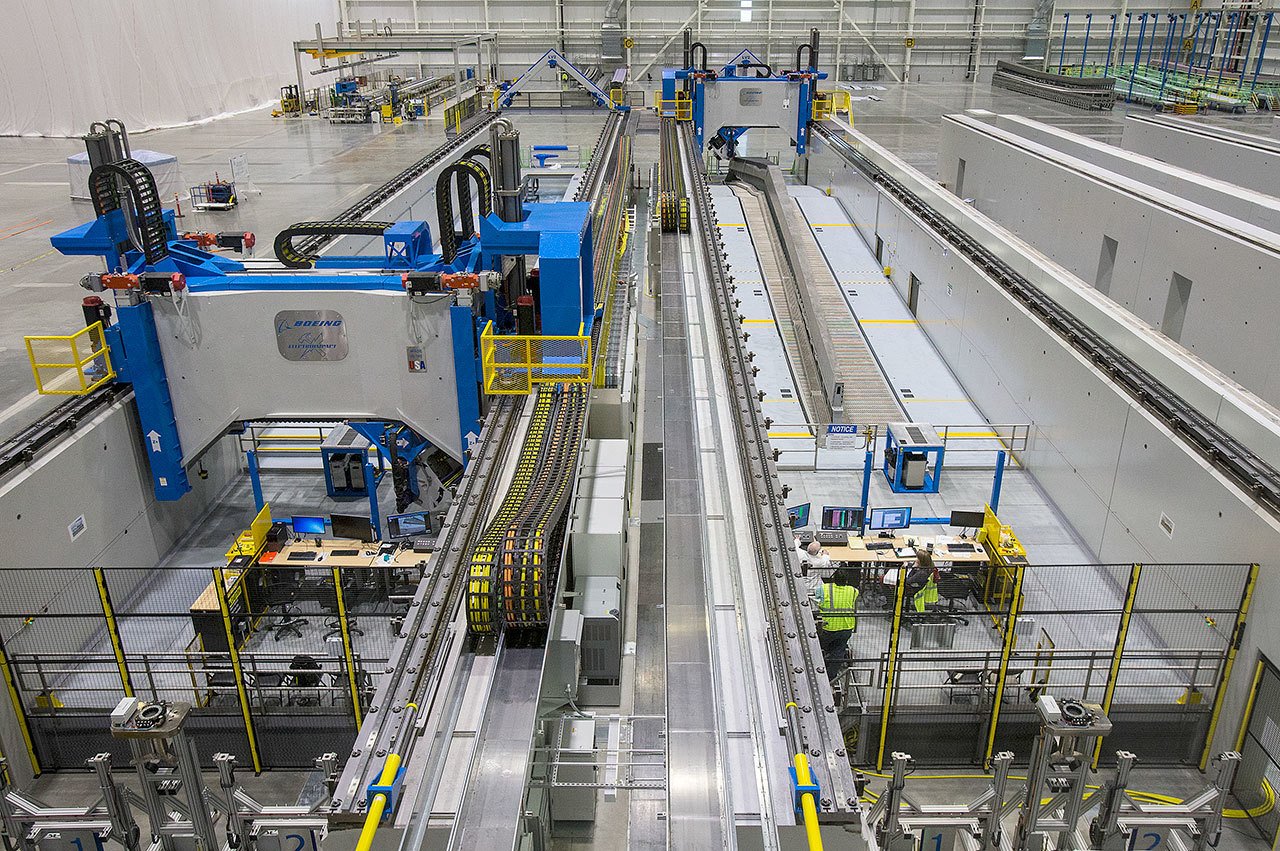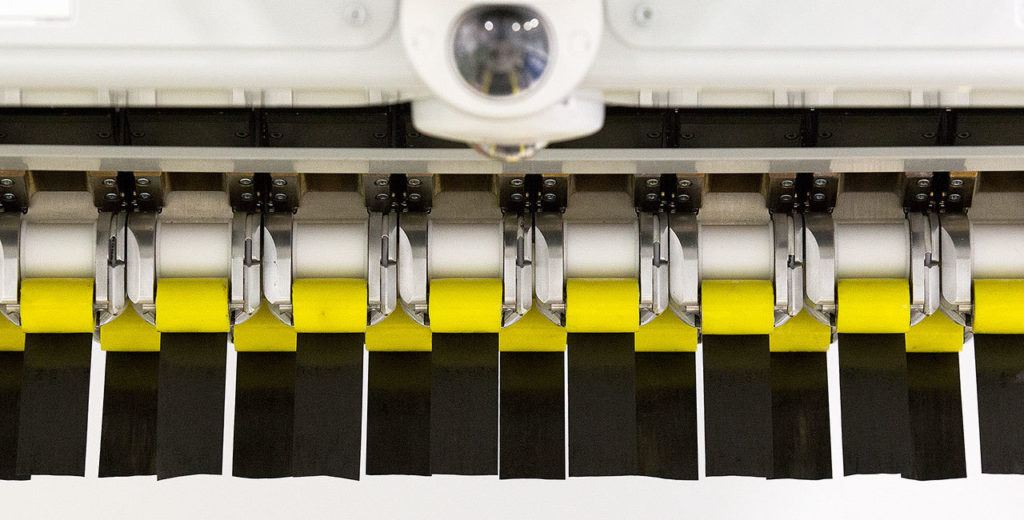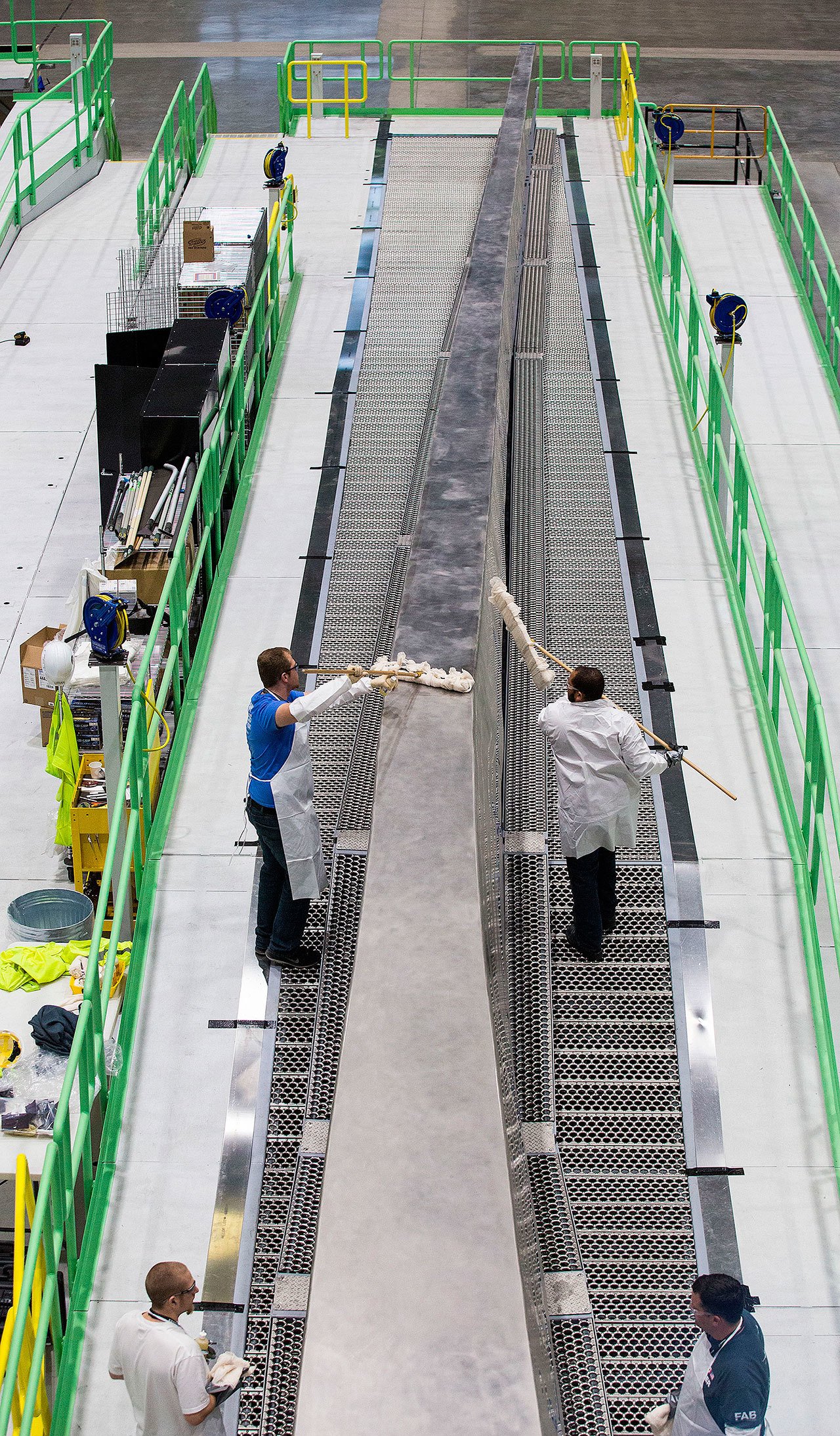The Boeing Co.’s Everett plant is weeks away from turning out the first production parts for its new airliner, the 777X.
Workers have spent months and months testing and certifying dozens of pieces of manufacturing equipment on the leading edge of production technology. By late March, they expect to be making parts for the first production 777X aircraft. That plane will never leave the ground. Instead, Boeing will bend, pull and push its wings, flaps, fuselage and other critical structures past their designed limits to ensure the 777X is as strong in real life as it is on paper.
Boeing’s 777X is a leap forward in airplane design and production technology. It will have the biggest composite-material wings for a commercial jetliner. And Boeing is leaping forward with automated manufacturing systems — using robots and other autonomous machines to do a greater number of jobs and more complex ones.
While the making of the airplane’s massive wings is moving along fairly smoothly, other innovations being introduced for 777X production are proving harder to execute, specifically a new way of assembling airplane fuselages using robotic machines to do much of that work now done by humans. In order to troubleshoot the new technology, Boeing started using it last year on its 777 classic program.
Since it first rolled out of Boeing’s Everett plant more than 20 years ago, the 777 classic has been a workhorse and one of Boeing’s biggest profit makers. Its successor — the 777X — is based on the 777 classic. However, it has too many new features to be considered another version of the 777. But the new airplane’s design is heavily based on its predecessor, so much so that Boeing declined to give it a new 7-series designation, such as 797. The 777X family now includes two versions: the smaller 777-8 and the larger 777-9.
The 777-9, the version slated for first delivery, is at 30 percent detailed design. It is still heavier than Boeing wants, but engineers have significantly reduced the problem in recent months, said Eric Lindblad, who took over the 777X program in October. Prior to that, he had overseen 777X wing production.
In the past five months, engineers have cut the excess weight by 50 percent, he said. “We can see our way to where we need to be when we’re done with detailed design.”
The program is on schedule as it moves through detailed design and into production.
“The amount of tooling and equipment we need, we put a lot of pressure on the supply stream,” Lindblad said.
Given that, plus the scope and complexity of the manufacturing processes that Boeing is implementing, “keeping everything on schedule has been difficult; it’s been constant” effort, he said.
Like any development program, unexpected problems arise.
“You have to throw a solution together. You get people together,” he said. “You beat the problem back down and get that one solved, and then something else pokes its head up, and you solve that one. It just seems like week after week, there’s always an issue.
“You have to pay attention — that’s the moral of the story,” he said.
Lindblad doesn’t mind the challenge. “If it was an easy job, I would’ve picked a different one,” he said.
One such challenge came on fuselage section 48, at the rear of the airplane. Most of the design work was done by Boeing engineers in Huntsville, Alabama, where the company does a lot of its rocket work.
“As we started getting further through detailed design, we learned we had not accounted for a specific load condition,” due to miscommunication, he said.
That issue has been addressed now.
Boeing spent more than $1 billion on a sprawling building called the Composite Wing Center in Everett, which opened in May. At 236 feet from tip to tip, the wings will be so long that they require folding wingtips to get around most airports. Composite materials allow airplane makers to build lighter, stronger structures that last longer than when they are made with metals.
“This carbon fiber wing — there’s nothing like it in the world,” Lindblad said.
Automated machines and robots will do most of the work, with human operators at the controls. As production ramps up, so too will the workforce, which could be up to 900 people in the Composite Wing Center.
Half of the massive building is a clean room, where machines operated by workers in white lab coats lay down miles of carbon-fiber tape over tooling to make the parts of the wing: skins, stringers and spars. The parts are then baked — or cured — until hardened, in the building’s giant autoclave.
After that, they are trimmed, drilled and inspected several times to ensure there are no weaknesses or flaws.
“You could get someone walking through the factory like you or I. We could have a piece of dust in our pocket. It could float out of our pocket and end up between two pieces of material, and no one would ever know it had happened,” he said.
That single speck of dust is enough to potentially compromise the part’s strength. Parts with flaws could be repaired or scrapped, depending on the situation, he said.
The center has one autoclave now. Boeing likely will add a second in 18 to 24 months in order to turn out more 777X airplanes, he said.
The huge wings and its new General Electric GE9X engines are the biggest reasons for the more efficient performance Boeing expects out of the airplane when it starts carrying passengers in a few years. The airplane will be able to fit 50 more passengers than its predecessor, the 777-300ER, and should burn less fuel — about 20 percent less per passenger.
The actual number of passengers depends on how individual airlines configure the interior.
The airplane drew a flurry of orders when Boeing unveiled it in 2013. Few have followed, but that is not cause for concern, industry analysts say.
Some airlines might be waiting to see how development proceeds before placing orders. Aircraft orders have slowed down in recent years, especially orders for twin-aisle airplanes, following a years-long spending spree by air carriers.
So far, Boeing has received 306 orders for the 777X. The majority — 253 — are for the bigger 777-9, which is slated to first be delivered in 2020. Airlines have ordered 53 of the smaller 777-8.
The company is still considering a 777-10, a stretched version of the 777-9, Lindblad said.
Dan Catchpole: 425-339-3454; dcatchpole@heraldnet.com. Twitter: @dcatchpole.
Talk to us
> Give us your news tips.
> Send us a letter to the editor.
> More Herald contact information.



























